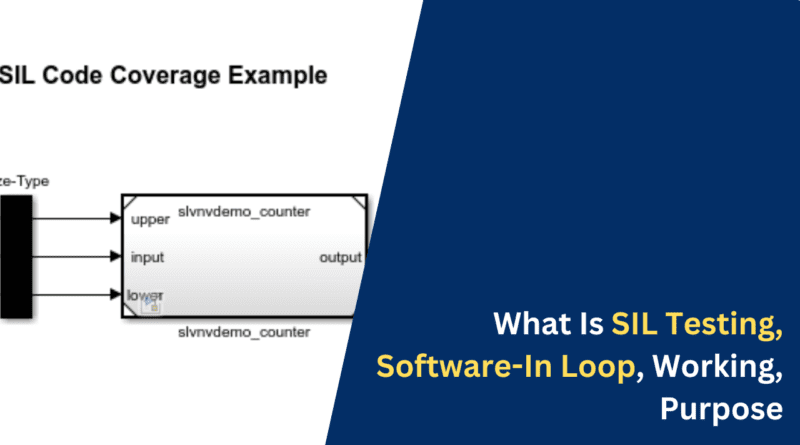What Is SIL Testing, Software-In Loop, Working, Purpose
Hello, guys, welcome to our blog. Here in this article, we will discuss SIL testing, software-in-the-loop, how SIL testing is different from MIL and HIL testing, and why SIL testing is required.
Ask questions if you have any electrical, electronics, or computer science doubts. You can also catch me on Instagram – CS Electrical & Electronics.
Also, read:
- UDS (Unified Diagnostic Services) Tutorials For Automotive Engineers
- What Is CPC (Common Powertrain Controller) ECU, Working of CPC
- What Is HiL, Hardware In Loop, Working, Tools Used In HiL
What Is SIL Testing, Software-In Loop
SIL testing, short for Software-in-the-Loop testing, constitutes a pivotal phase in the development and validation of software, particularly in domains involving embedded systems and control engineering. This method involves the meticulous testing of software code within a simulated or virtual environment, circumventing the need for physical hardware during initial testing phases.
The primary goal of SIL testing is to thoroughly validate software functionality, performance, and behavior within a simulated environment. This environment could comprise mathematical models, simulators, or virtual representations that mimic the anticipated operational conditions. Crucially, SIL testing isolates the software component from the actual hardware, allowing for early-stage validation and debugging. This isolation mitigates risks associated with late-stage errors and substantially reduces costs tied to rectifying flaws post-integration.
SIL testing unfolds through a structured process. It begins with an exhaustive analysis of software requirements to establish a solid foundation for testing. Subsequently, the software code is developed based on these stipulated requirements. Once the code is in place, a simulated environment is set up for testing purposes. Test cases, meticulously designed to encompass diverse functionality aspects and scenarios, are then executed within this environment. Post-execution, any identified issues are debugged, and the software undergoes refinement before subsequent rounds of testing.
Several advantages underscore the significance of SIL testing. Early detection and rectification of software defects during the developmental stage significantly reduce costs and time associated with identifying errors post-hardware integration. It also effectively mitigates risks linked to potential software failures when integrated with hardware. SIL testing offers repeatability and control, allowing for the replication of tests under controlled conditions, thereby ensuring consistent evaluation and improvement.
How SIL testing is different from MIL and HIL testing
SIL (Software-in-the-Loop), MIL (Model-in-the-Loop), and HIL (Hardware-in-the-Loop) testing are distinct phases in the development and testing of complex systems, each focusing on different aspects and stages of the system integration process.
SIL Testing:
- Focus: Primarily concentrates on testing software components in a simulated environment without hardware integration.
- Environment: Involves simulators, mathematical models, or virtual representations to validate software functionality and behavior.
- Isolation: Software is tested in isolation from physical hardware, allowing early-stage testing, debugging, and verification.
- Advantages: Early identification of software issues, cost reduction, risk mitigation, and controlled, repeatable testing environments.
MIL Testing:
- Focus: Tests the behavior and functionality of a software model in a simulated or virtual environment.
- Model Usage: In MIL testing, the emphasis is on the behavior and performance of the model itself rather than the software code derived from it.
- Early-stage Validation: It’s used to verify the accuracy of the model against specified requirements before software development begins.
- Advantages: Enables validation of models before code implementation, ensuring the model accurately represents the system’s behavior.
HIL Testing:
- Focus: Involves testing the integration of software with physical hardware components.
- Simulation: Uses real hardware components to validate the interaction between software and hardware.
- Real-time Conditions: Mimics real-time conditions, allowing thorough testing of the software’s interaction with physical devices and sensors.
- Advantages: Validates the software’s performance in conjunction with actual hardware, identifying issues related to hardware-software interactions.
Differences:
- Scope: SIL tests software in a simulated environment without hardware, MIL verifies software models, and HIL integrates software with actual hardware.
- Integration Stage: SIL and MIL occur before hardware integration, whereas HIL specifically tests the software and hardware interaction.
- Testing Environment: SIL and MIL utilize simulated or virtual environments, whereas HIL involves actual hardware components.
- Focus: SIL focuses solely on software, MIL tests software models, and HIL tests software and hardware integration.
While SIL, MIL, and HIL testing are distinct, they complement each other in ensuring the overall reliability, functionality, and performance of complex systems throughout various stages of development, from software validation to hardware-software integration.
Why SIL testing is required?
SIL (Software-in-the-Loop) testing is essential for several reasons that greatly influence the development and reliability of software-intensive systems:
a. Early Detection of Issues:
SIL testing allows the identification and rectification of software defects in the early stages of development. By testing software in a simulated environment before hardware integration, potential issues can be discovered and addressed without the complexities and costs associated with physical hardware.
b. Cost and Time Efficiency:
Identifying and rectifying errors post-hardware integration can be extremely costly and time-consuming. SIL testing significantly reduces these costs by catching issues early in the development process, preventing expensive reworks and iterations later on.
c. Risk Mitigation:
Software failures can lead to system malfunctions or even safety hazards when integrated with hardware. SIL testing mitigates these risks by ensuring that software functions correctly and reliably before it interacts with physical components. It helps prevent potential hazards and ensures system stability.
d. Iterative Development:
SIL testing enables an iterative development process. Developers can continuously refine and improve the software based on test results, making incremental changes and enhancements in a controlled environment before integration with hardware. This iterative approach fosters better-quality software.
e. Enhanced Software Quality:
By rigorously testing software functionality, performance, and behavior in a controlled environment, SIL testing contributes to higher software quality. It helps meet specified requirements and ensures that the software behaves as expected under various conditions.
f. Regulatory Compliance and Standards:
In industries with stringent regulatory requirements like aerospace, automotive, and medical devices, SIL testing is often mandated. It helps in complying with industry standards and regulations by ensuring that software meets safety and performance criteria.
In summary, SIL testing is indispensable in software development as it not only improves software quality but also reduces costs, mitigates risks, and ensures that software functions correctly before integration with hardware, thereby contributing to the overall reliability of complex systems.
Different types of tools used for SIL Testing in Automotive
In the automotive industry, SIL (Software-in-the-Loop) testing tools play a crucial role in ensuring the functionality, performance, and safety of software components before their integration into vehicles. These tools facilitate the simulation and validation of software in a controlled environment. Here are some types of tools commonly used for SIL testing in automotive applications:
Model-Based Development Tools:
- MATLAB/Simulink: Widely used for modeling and simulation in automotive SIL testing. It allows the creation of mathematical models for various vehicle systems and control algorithms.
Simulation and Test Environment Tools:
- dSPACE VEOS: Provides a virtual environment for testing electronic control units (ECUs) and control algorithms before integration with real hardware.
- NI VeriStand: Enables the creation of real-time test applications to validate automotive software models and control systems.
Software Testing and Verification Tools:
- VectorCAST: A unit and integration testing tool that automates test creation, execution, and analysis for embedded software in automotive systems.
- LDRA Testbed: Helps in software verification and validation by analyzing source code and ensuring compliance with industry standards like MISRA and ISO 26262.
Simulation Platforms and Middleware:
- CarSim: Simulates vehicle dynamics, enabling the evaluation of control systems’ performance in different driving scenarios.
- dSPACE Automotive Simulation Models (ASM): Offers various simulation models for vehicle dynamics, powertrain, and driver assistance systems.
This was about “What Is SIL Testing, Software-In Loop“. Thank you for reading.
Also, read:
- 10 Tips To Maintain Battery For Long Life, Battery Maintainance
- 10 Tips To Save Electricity Bills, Save Money By Saving Electricity
- 100 (AI) Artificial Intelligence Applications In The Automotive Industry
- 100 + Electrical Engineering Projects For Students, Engineers
- 1000+ Control System Quiz, Top MCQ On Control System
- 1000+ Electrical Machines Quiz, Top MCQs On Electrical Machines
- 1000+ MATLAB Simulink Projects For MTech, Engineering Students
- 50 Tips To Save Electricity At Home, Shop, Industry, Office
Author Profile
- Chetu
- Interest's ~ Engineering | Entrepreneurship | Politics | History | Travelling | Content Writing | Technology | Cooking
Latest entries
 All PostsApril 19, 2024What Is Vector CANoe Tool, Why It Is Used In The Automotive Industry
All PostsApril 19, 2024What Is Vector CANoe Tool, Why It Is Used In The Automotive Industry All PostsApril 13, 2024What Is TCM, Transmission Control Module, Working, Purpose,
All PostsApril 13, 2024What Is TCM, Transmission Control Module, Working, Purpose, All PostsApril 12, 2024Top 100 HiL hardware in loop Interview Questions With Answers For Engineers
All PostsApril 12, 2024Top 100 HiL hardware in loop Interview Questions With Answers For Engineers All PostsMarch 22, 2024Driver Monitoring Systems In Vehicles, Working, Driver Sleepy Alert
All PostsMarch 22, 2024Driver Monitoring Systems In Vehicles, Working, Driver Sleepy Alert








